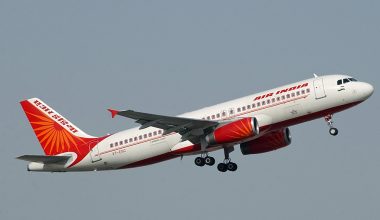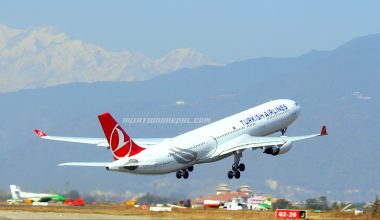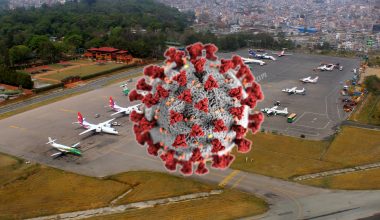Kathmandu is one of the most beautiful cities globally, encompassing eye-popping art and architecture, heart-melting hospitality, captivating culture, and its own unique vibe. Kathmandu has been wooing its visitors for centuries. Kathmandu welcomes all types of visitors from different parts of the world through its airport. The first and only international airport in operation till now is in Kathmandu. Tribhuvan International Airport, Nepal’s pride, is an airport in Kathmandu, serving Nepalese foreigners connecting Nepal to larger population centers and their markets, changing the potentials for Nepal’s economic development. Located 5.6 km away from Kathmandu, it is owned by the Government of Nepal. Tribhuvan International Airport in Kathmandu connects Nepal to an extensive network of over 40 destinations in 17 countries, including India, China, Qatar, Malaysia, Saudi Arabia, etc.

The lockdown and halting of flights due to the COVID outbreak have given this airport time to facelift its facilities. Often voted as ‘One of the world’s worst airports”, Nepal’s sole aerial gateway is upgraded, with the parking area being expanded, a newly paved runway extended by 300 meters at the southern end, and additional space in domestic and international terminals. The new pre-departure sterile area of Kathmandu airport can hold up to 1500 people at a time. The face of the airport has changed with the arrival terminal spruced up, floor marking in the check-in, and immigration area to ensure social distancing. Although the runway is upgraded with an installment of new approach lights, the taxiway hasn’t been extended, which otherwise would have shortened the holding time of aircraft, leading to lower congestion. However, this is a huge improvement for this airport in the country, looking at how the country has dealt with lockdowns, and economy, backed by political instability and baby steps for developmental works.
Also Read: Free bus shuttle service launched at Tribhuvan International Airport
The airport serving Kathmandu is the hub for many different airlines, including domestic and international. The national flag carrier of Nepal, Nepal Airlines, and another international airline of Nepal, Himalayan Airlines, concentrates its traffic flow from this airport in Kathmandu. The domestic and regional carriers like Buddha Air, Nepal Airlines, Saurya Airlines, Shree Airlines, Simrik Airlines, Sita Air, Tara Air, and Yeti Airlines also have made TIA their hubs.
The airport operates with a runway situated on top of the hill and one domestic and international terminal. As Tribhuvan International Airport’s transportation networks are improved and developed, it has been bringing distant destinations much close to Nepal. In 2019, it transported over 7 million passengers being the hub of all air services in the country. It has the IATA code KTM and ICAO code of VNKT. It has been generating greater benefits to its passengers and the wider economy by providing speedy connections between Kathmandu and other international cities. It stimulates foreign direct investment, foreign tourist expenditure, and the inflow of cargos, people, ideas, and other goods. The airport in the nation’s capital is operated by the Civil Aviation Authority of Nepal (CAAN).
The majority of airfields all over the world are still equipped with easy and simple facilities. Although TIA is not such a sophisticated airport for catering to most needs of the passengers, crew, and cargos, it has evolved to meet the needs of modern air transport with the following infrastructures:
1. Apron
The international apron at Tribhuvan International Airport can accommodate 3wide-body aircraft, 15 in total; for loading, unloading of passengers and cargos, fueling, maintenance, and aircraft parking and boarding. The eastern bay can support two wide-bodies and two ATR 72 or other similar twin-engine turboprop aircraft, which is utilized by non-operational airplanes. Two new aprons are underway to accommodate the international aircraft capacity to the south of present aprons.

The domestic apron can hold up to 35 aircraft, although the allowed capacity is only 17. Passengers can embark, disembark; the aircraft can board, unboard, and park on the airport apron. It is a sensitive area where a large number of people are performing complicated tasks, all at a time.
2. Runway
The airport in Kathmandu, Tribhuvan International Airport, has a tabletop runway, extended to the distance of 3350 meters, installed with high-intensity centerline lights, runway end lights, and bidirectional raised edge lights. The only runway is laid in concrete and was extended to 3350 meters in 1975. There is no instrumental landing system to provide short-range guidance to aircraft on the runway, making it prone to ensuring safe landing at night or in bad weather.

3. Terminals
Two terminals of Tribhuvan International Airport are for domestic and international operations. There is also a VIP terminal. There’s an executive lounge available for reservation by business class passengers to relax and have a comfortable time.

4. Navigation aids
The Kathmandu airport has two non-precision systems for providing handling information; VHF and RNAV (Required Area Navigation).

5. Aircraft maintenance
A hangar operated by Nepal Airlines provides a maintenance and repair facility. Buddha Air also owns a state-of-art closed-door aircraft hangar occupying an area of 37000 square feet at TIA, certified as part 145 Aircraft Maintenance Organization from CAAN.

Services at Kathmandu Airport – Air Traffic Control Service, Aeronautical Communication Service, and Aeronautical Information Service
Passenger Facility at Airport in Kathmandu
There are different facilities for passengers traveling to/from Kathmandu airport. Some of these facilities are:
- Free Wi-Fi from departure area to arrival
- Cargo facilities for handling incoming and outgoing cargos,
- NTB Information counter for Nepal’s tourism promotion and branding.
- Parking facilities, pre-paid taxis
- Information desks where one can inquire about the flight schedules, check-in counters
- Police help desk regarding flight schedules lost and found, etc.
- Self-check-in services where passengers can self-check-in and collect their boarding card
- Banking facilities such as ATM, currency exchange facilities
- Restaurants and shops, duty-free shops
- Pressroom for conducting a press conference
- Trolley services which are free of cost
- Medical services such as first-aid and ambulance facility
- Baggage help desk to report baggage related problems, information regarding one’s own baggage,
- Post office service
- HAN counter to book hotel in Nepal
As the international airport, TIA has helped expand Nepal’s business relations within and outside the country. Catering to both domestic and international airlines, it has a premium for immediate connections to clients and suppliers, hence playing a critical role in the economic success of Nepal.

The Kathmandu located airport has various goals and objectives to reach the pinnacle of aviation success. Some of them are:
- To ensure safe, secure, and quality air traffic for their orderly movement.
- Equip airport with needed infrastructure serving visitors to promote tourism in Nepal.
- Administration, management, and monitoring of established policy pertaining to airport operations and management via service standards.
- Strive to achieve environmentally clean TIA, devoid of pollution.
- Balance different components of operations (facilitation vs. security vs. commercial) through coordination with TIA affiliated agencies.
If we look back to the aviation history of Nepal, TIA has been the backbone when it was metamorphosed into an airport from cow-grazing pasture. The history can be traced back to 1949 when the aircraft of Indian Ambassador Sarjit Singh Mahathir landed at Gauchar (cow grazing pasture). The official inauguration of the airport was on 15 June 1955, by king Mahendra. The previous name, “Gauchar Airport,” was renamed “Tribhuvan Airport” by the king in memory of his father. The airport became Tribhuvan International Airport in 1964 and has been named the same since then.
The development starting with its name, continued to the extension of the runway, with operation/airline and control tower building completion in 1987 and completion of the international terminal building in 1989. With the Nepal government’s ‘Liberal Sky Policy,’ a handful of private airlines entered the domestic air market of Nepal. In the 1990s, technical works started rapidly in the airport in Kathmandu, i.e., TIA. In 1994, the international and domestic apron expanded, and the ATC rating, a licensing system were launched. 1995 marked the starting of work related to ASR/SSR radar system, domestic terminal building expansion.
TIA was expanded under Air Transport Capacity Enhancement Project (ATCEP), from the period 2010 to 2023, divided into 2 phases of construction. Phase I construction plans include:
- Expansion of international apron
- Demolition of the domestic terminal
- Construction of new 14 km taxiway
- Refurbishment of the international terminal building
Phase II plans include converting the present international terminal into domestic while constructing a new passenger terminal, commercial terminal development, etc.
What is Kathmandu Airport lagging behind?
Prior to 2020, Kathmandu Airport or TIA was poor at delivering an exceptional passenger experience, with a non-hygienic domestic terminal, inadequate signage, and food option. The long immigration line, multiple hurdles through checkpoints, and crumbling infrastructures added to passenger discomfort. There was air traffic congestion due to the reason that it was only the international airport of Nepal.
Poor visibility induced by air pollution and weather, insufficient equipment, inclement weather, single runway, and one-way approach were the reasons behind flight delay in Tribhuvan International Airport.
However, the country’s main gateway has improved international terminal now in terms of facilities. It is still not enough compared to other airports of the world. The airport should strive to achieve efficiency in the reliability of service, the pursuit of convenience for passengers, and offer on-time departure for airlines with adequate infrastructures and facilities.






